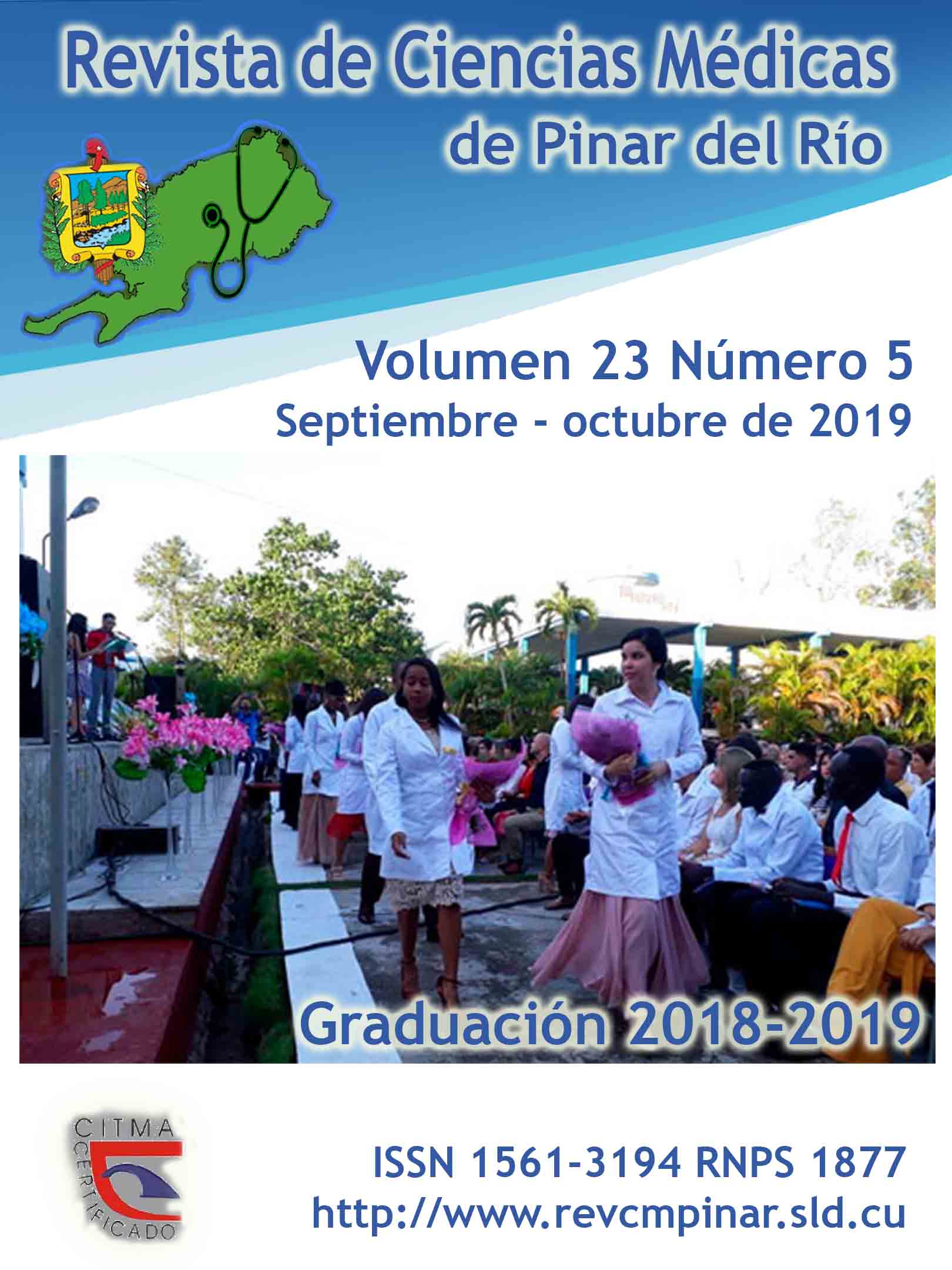Behavior of fragility, polypharmacy and self-validism in the elderly-quality of life
Keywords:
FRAILTY, QUALITY OF LIFE, AGED, NONAGENARY, POLYPHARMACY.Abstract
Introduction: the ageing of the population, one of the greatest triumphs of humanity and also one of the greatest challenges to which the province of Pinar del Río is not unaware.
Objective: to evaluate the behavior of fragility, polypharmacy, and self-validism in the elderly-quality of life admitted to Dr. Leon Cuervo Rubio de Pinar del Rio Clinical Surgical Teaching Hospital during the years 2016 and 2017.
Methods: it was a descriptive, analytical and cross-sectional study in a group of older people admitted to the chosen provincial hospital, the target group comprised 673 patients and the sample 642 admitted during the period covered, who met the inclusion criteria. Descriptive statistics and absolute and relative percentage frequencies were applied.
Results: male gender predominated; the age group that stood out was 90-94 years. The highest percentage of nonagenarians were fragile, and a small part independent for the performance of activities of daily living, most of them requiring frequently assistance. Polypharmacy proved to be a real problem in longevity. All the criteria evaluated had a negative impact on the quality of life of the longevos, medium rate over the high category predominated.
Conclusions: it was demonstrated that the existing relationship among fragility, polypharmacy and self-validism as determinants had a direct impact on the assessment of the quality of life of longevos.
Downloads
References
1. Organización Mundial de Salud. Informe mundial sobre el envejecimiento y la salud. OMS [Internet] 2015 [citado 05/11/2017]. Disponible en https://apps.who.int/iris/bitstream/handle/10665/186466/9789240694873_spa.pdf;jsessionid=81374C2FFBA4CB2ED0F9506F99387B7E?sequence=1
2. Anuario Estadística de Salud 2016. [Internet]. La Habana: MINSAP; 2017 [Citado 13/012018]. Disponible en: http://files.sld.cu/dne/files/2017/05/Anuario_Estad%C3%ADstico_de_Salud_e_2016_edici%C3%B3n_2017.pdf
3. Pedraja García E, Mederos González E, Rosales Jiménez A, Ibarez Castro A, Herrera González MM. Evaluación funcional, cognitiva y biomédica de ancianos de 90 años y más. Rev Acta Médica del Centro [Internet]. 2015 [Citado 11/01/2017]; 9(2). Disponible en: http://www.revactamedicacentro.sld.cu/index.php/amc/article/view/252/404
4. Cala Calviño L, Casas Gross S, Dunán Cruz LK. Efecto cascada en el anciano como consecuencia de la polifarmacia. MEDISAN [Internet] 2017 Mar [citado 18/11/2017]; 21(3): [aprox. 7p.]. Disponible en: http://scielo.sld.cu/scielo.php?script=sci_arttext&pid=S1029-30192017000300006&lng=es.
5. Díaz Alfonso H, Lemus Fajardo N M, Gonzáles Cosme W, Licort Monduy O, Gort Cuba O. Repercusión ética del cuidador agotado en la calidad de vida de los ancianos. Rev Ciencias Médicas [Internet]. 2015 Jun [citado11/11/ 2017]; 19(3): [aprox. 12p.]. Disponible en: http://scielo.sld.cu/scielo.php?script=sci_arttext&pid=S1561-31942015000300011&lng=es.
6. Runzer Colmenaresa F, Urrunaga Pastorb D, Aguirreb LG, et al. Fragilidad y vulnerabilidad como predictores de radiotoxicidad en adultos mayores: un estudio longitudinal en Perú. Rev Med Clin [Internet] 2017 [citado 11/01/2018]; 149(8): [aprox. 5p.]. Disponible en: https://www.clinicalkey.es/service/content/pdf/watermarked/1-s2.0-S0025775317301860.pdf?locale=es_ES
7. Abizanda Soler P, Rodríguez Mañas L. Fragilidad en el anciano. En: Abizanda Soler P. Tratado de Medicina Geriátrica. España: Elseiver; 2015; p.383-391.
Lluis Ramos Guido E. Prevalencia de la fragilidad en adultos mayores del municipio La Lisa. Rev Cub Med Mil [Internet]. 2016 Mar [citado 2018 Mar 09]; 45(1): [aprox. 8p.]. Disponible en: http://scielo.sld.cu/scielo.php?script=sci_arttext&pid=S0138-65572016000100003&lng=es.
8. Oscanoa T, Romero Ortuno R, Cruz Jentoft A. Estereotipos negativos asociados a la fragilidad en personas mayores. Rev Esp Geriatr Gerontol. [Internet]. 2016 Jul; [citado 08/11/2017]. 51(4): [aprox. 3p.]. Disponible en: https://www.clinicalkey.es/#!/content/playContent/1-s2.0-S0211139X16000548?returnurl=https:%2F%2Flinkinghub.elsevier.com%2Fretrieve%2Fpii%2FS0211139X16000548%3Fshowall%3Dtrue&referrer=
9. Lee Goldman MD, editor. Goldman- Cecil Tratado de medicina interna, 25ta Ed. España. Elsevier; 2016.
10.Rivas Cobasa PC, Ramírez Duquea N, Gómez Hernández M, et al. Características del uso inadecuado de medicamentos en pacientes pluripatológicos de edad avanzada. Gac Sanit [Internet] 2017 Jul [Citado 11/01/2018]; 31(4): [aprox. 5p.]. Disponible en: http://dx.doi.org/10.1016/j.gaceta.2016.06.013
11. Gutiérrez Valenccia M, Larrayoz Solas B, Monteforte Gasquez MP, Martínez Velilla N. Enfoques complementarios en ancianos con polifarmacia: aproximación a Sector es más vulnerables. Rev Esp Geriatr Gerontol [Internet] 2017 May [Citado 2018 Ene]; 52(3): [aprox. 1p.]. Disponible en: https://medes.com/publication/120748
12. Castro Rodríguez J, Orozco Hernández J, Marín Medina D. Polifarmacia y prescripción de medicamentos potencialmente no apropiados en ancianos. Rev. Méd. Risaralda [Internet] 2016 [citado11/06/2017]; 22(1): [aprox. 5p.]. Disponible en: http://www.scielo.org.co/pdf/rmri/v21n2/v21n2a11.pdf
13. Robles A, Hernández Martínez E, Delabra Salinas M, Covarrubias-Solís I, Leija Mendoza A, Ponce Ibarra B. Calidad de vida y polifarmacia del adulto mayor integrante del programa “adultos mayores empacadores”. Nure Inv [Internet]. 2017 [citado 11/01/2018]; 14(91): [aprox. 9p.]. Disponible en: http://www.nureinvestigacion.es/OJS/index.php/nure/article/view/1206
14. Sánchez Padilla L M, González Pérez U, Alerm González A, Bacallao Gallestey J. Calidad de vida psíquica y estado de salud física en el adulto mayor. Rev haban cienc méd [Internet]. 2014 Abr [citado 18/03/2016]; 13(2): [aprox. 10p.]. Disponible en: http://scielo.sld.cu/scielo.php?script=sci_arttext&pid=S1729-519X2014000200017&lng=es.
Published
How to Cite
Issue
Section
License
Authors who have publications with this journal agree to the following terms: Authors will retain their copyrights and grant the journal the right of first publication of their work, which will be publication of their work, which will be simultaneously subject to the Creative Commons Attribution License (CC-BY-NC 4.0) that allows third parties to share the work as long as its author and first publication in this journal are indicated.
Authors may adopt other non-exclusive license agreements for distribution of the published version of the work (e.g.: deposit it in an institutional telematic archive or publish it in a volume). Likewise, and according to the recommendations of the Medical Sciences Editorial (ECIMED), authors must declare in each article their contribution according to the CRediT taxonomy (contributor roles). This taxonomy includes 14 roles, which can be used to represent the tasks typically performed by contributors in scientific academic production. It should be consulted in monograph) whenever initial publication in this journal is indicated. Authors are allowed and encouraged to disseminate their work through the Internet (e.g., in institutional telematic archives or on their web page) before and during the submission process, which may produce interesting exchanges and increase citations of the published work. (See The effect of open access). https://casrai.org/credit/



